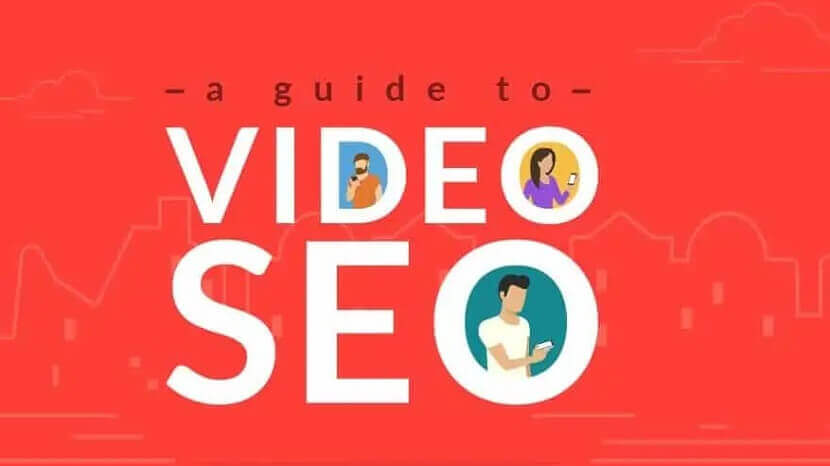Video for Search Engine Optimisation (SEO)
Last updated on January 19, 2025 by RGB Web Tech

Video SEO, or Search Engine Optimization, is the practice of optimizing video content to rank higher in search engine results pages (SERPs). With the proliferation of video content on platforms like YouTube, Vimeo, and social media, effective Video SEO has become crucial for businesses and content creators to increase visibility and drive organic traffic to their videos. It involves various strategies, including keyword research, optimizing video titles, descriptions, and tags, improving video quality and engagement metrics, as well as incorporating structured data markup. Successful Video SEO not only boosts search rankings but also enhances user experience, resulting in higher engagement and conversions.
What is Video SEO?
Video SEO, or Video Search Engine Optimization, refers to the process of optimizing video content to improve its visibility and ranking in search engine results pages (SERPs). It involves various techniques and strategies aimed at making videos more discoverable by search engines like Google, Bing, and YouTube.
Video SEO Techniques
Video SEO techniques are essential for maximizing the visibility and reach of your video content. Here are some effective techniques:
- Keyword Research: Identify relevant keywords related to your video content using tools like Google Keyword Planner, SEMrush, or Ahrefs. Use these keywords strategically in your video titles, descriptions, and tags.
- Optimize Video Titles and Descriptions: Craft compelling titles that accurately reflect the content of your video and include primary keywords. Write detailed and keyword-rich descriptions that provide context and encourage viewers to watch.
- Create Engaging Thumbnails: Design visually appealing thumbnails that accurately represent your video's content and entice viewers to click. Test different thumbnail designs to see which ones perform best.
- Transcriptions and Closed Captions: Provide transcriptions or closed captions for your videos to improve accessibility and make your content more searchable. Search engines can crawl the text within your videos, enhancing their visibility in search results.
- Optimize Video Metadata: Use relevant tags and categories to categorize your videos appropriately. This helps search engines understand the content of your videos and improves their chances of ranking for relevant search queries.
- Improve Video Loading Speed: Optimize your videos for faster loading times to enhance user experience and reduce bounce rates. Compress video files, leverage browser caching, and utilize content delivery networks (CDNs) to improve performance.
- Promote Video Across Multiple Channels: Share your videos on social media platforms, embed them on your website or blog, and include them in email newsletters to reach a wider audience and drive traffic back to your video content.
- Encourage User Engagement: Encourage viewers to like, comment, share, and subscribe to your channel. Engaging with your audience signals to search engines that your content is valuable and can improve its ranking in search results.
- Monitor and Analyze Performance: Use analytics tools like YouTube Analytics or Google Analytics to track the performance of your videos. Monitor metrics such as views, watch time, audience retention, and conversion rates to identify areas for improvement and refine your Video SEO strategy.
Frequently Asked Questions (FAQs) about Video SEO:
1. What is Video SEO?
Answer : Video SEO, or Video Search Engine Optimization, involves optimizing video content to improve its visibility and ranking in search engine results pages (SERPs).
2. Why is Video SEO important?
Answer : Video SEO helps increase the visibility of your video content, attract more viewers, and drive organic traffic to your website or channel. It can also enhance user engagement and conversions.
3. How do I optimize my videos for SEO?
Answer : To optimize your videos for SEO, focus on keyword research, optimizing metadata (titles, descriptions, tags), creating engaging thumbnails, providing transcriptions or closed captions, and promoting your videos across multiple channels.
4. Which platforms support Video SEO?
Answer : Video SEO techniques can be applied to various platforms, including YouTube, Vimeo, Facebook, Instagram, and your own website or blog.
5. What are the best practices for Video SEO?
Answer : Best practices for Video SEO include creating high-quality, relevant content, using descriptive titles and tags, optimizing video thumbnails, providing transcriptions, promoting your videos, and monitoring performance metrics.
6. How can I improve user engagement with my videos?
Answer : Encourage user engagement by asking viewers to like, comment, share, and subscribe to your channel. Respond to comments and engage with your audience to build a community around your videos.
7. Does video quality affect SEO?
Answer : While video quality itself may not directly impact SEO, high-quality videos tend to attract more viewers and engagement, which can indirectly improve SEO performance.
8. Is it important to include keywords in video titles and descriptions?
Answer : Yes, including relevant keywords in your video titles, descriptions, and tags helps search engines understand the content of your videos and improves their chances of ranking for relevant search queries.
9. How long should my videos be for optimal SEO?
Answer : The ideal video length depends on your content and audience preferences. However, aim to keep your videos informative, engaging, and concise, focusing on delivering value rather than meeting a specific length requirement.
10. How can I track the performance of my videos?
Answer : Use analytics tools such as YouTube Analytics, Google Analytics, or platform-specific insights to monitor metrics like views, watch time, audience retention, and conversion rates. Use this data to refine your Video SEO strategy over time.
Conclusion of Video SEO
In conclusion, Video SEO plays a pivotal role in enhancing the visibility and reach of video content across various platforms. By implementing strategic optimization techniques such as keyword research, metadata optimization, and user engagement tactics, businesses and content creators can improve their video rankings in search engine results pages (SERPs) and attract more organic traffic. Moreover, fostering user engagement and providing high-quality, relevant content are essential for sustaining audience interest and driving conversions. Continuously monitoring performance metrics and adapting strategies accordingly ensures the effectiveness of Video SEO efforts, ultimately leading to increased visibility, engagement, and success in the digital landscape.
If you found this article helpful, we encourage you to share it on your social media platforms—because sharing is caring! For more information about article submissions on our website, feel free to reach out to us via email.
Send an emailWritten by RGB Web Tech
Latest Technology Trends
Latest technology trends shaping the future, including AI advancements, blockchain innovation, 5G connectivity, IoT integration, and sustainable tech solutions. Explore breakthroughs in quantum computing, cybersecurity, augmented reality, and edge computing. Stay ahead with insights into transformative technologies driving innovation across industries and revolutionizing how we live, work, and connect.
9 Video Trends for Your Brand Marketing 2025
Last updated on January 19, 2025 by RGB Web Tech

In the space of a few years, video marketing has transformed from a “nice-to-have” into a “must-have” for every modern brand. In 2025, it’s clear that video is not just a format. It’s a full-fledged brand marketing strategy that is driving engagement, conversions, and long-term customer loyalty.
There are numerous startups that want to break through the noise. And there are established businesses that want to stay relevant. All of them need to stay ahead of the latest marketing trends.
We’ll explore major video trends that are redefining video content marketing in 2025. We’ll also delve into how your brand can capitalize on them.
1. AI-powered video creation is the new norm
Not so long ago, many weren’t sure how to take advantage of artificial intelligence. Now we can see one of the most revolutionary shifts. It’s the widespread use of video making software that is powered by AI. Such tools can now assist with everything from script generation and scene selection to auto-editing and personalization for different demographics.
What does it mean for marketers? It means that they can create more content in less time. Most importantly, they don’t need to sacrifice quality. The technology can analyze audience behavior and suggest to content creators what the optimal length, tone, and style of videos should be. Isn’t that amazing?
If you haven’t explored such tools, it’s time to taste the waters. It’s also interesting that these platforms are becoming more user-friendly and affordable. Reasonable costs of subscriptions make it more accessible for brands of all sizes to produce high-quality content.
2. Cross-platform video repurposing and format conversion
There are numerous platforms where brands can market their videos. However, not all of them require one and only format. They differ. In such a case, having a reliable video converter is more important than ever. You may want to turn your long video created for YouTube into short clips for Reels. And there might be a need to convert file types for compatibility. Such a tool will help you make sure your content reaches more people. It’ll also save you much more time than if you had to produce new content for another platform.
Besides, it might depend on the camera you use. If you work with older or high-definition camera formats, you might need to learn how to convert AVCHD to MP4 to make your footage compatible with online platforms and editing software. In a number of cases, MP4 is a way to go for seamless sharing and publishing.

3. Vertical and short-form video continue to surge
Thanks to TikTok, Instagram, and YouTube, short-form and vertical videos are no longer just trends. They’re staples. They will continue to dominate social media trends for more and more years to come. All because users crave quick and digestible content that entertains or informs within seconds.
If your brand can’t produce high-impact storytelling in under a minute, you’ll be the one to stand out. When searching for a video editor, you should make sure it supports vertical editing, transitions, and mobile-friendly text overlays.
4. AI in your social media strategy
Additionally, marketers are turning to artificial intelligence in their social media strategy. In this way, they can better manage distribution and engagement. Here’s what AI tools offer:
- Schedule posts at peak times;
- Predict which video types will perform best;
- Monitor sentiment analysis in real time.
Besides, such tools can help you repurpose content effectively. Meaning that your videos work harder across multiple channels.
5. Interactive videos for higher engagement
Users want something more than passive content. They also want to participate. How can you do that? You can generate clickable hotspots, live Q&As, or viewer-driven storylines.
Interactive videos give you a deeper emotional connection with your audiences. Ultimately, they boost engagement rates. These formats are especially useful for eCommerce, education, and service-based industries.
6. Smart optimization
You can imagine that the internet is overflowing with content. Are your videos easy to discover? Video SEO is no longer just about including keywords in titles. It now includes optimizing transcripts, thumbnails, video schema markup, and even voice search compatibility.
You need to make sure that your clips are indexed properly by search engines and platforms like YouTube, TikTok, and Instagram. You should also provide captions, metadata, and engaging descriptions that can dramatically improve visibility.

7. Behind-the-scenes content builds trust
Users want brands to be transparent and relatable. That’s why behind-the-scenes and day-in-the-life videos have become a massive part of social media trends in 2025. Such clips can humanize your brand. You can show the people behind the products or services, a team brainstorming session, or even the bloopers. In this way, you’ll have a genuine connection with your followers.
8. Data-driven personalization
The future of brand marketing strategy lies in personalization. Video is no exception. Since brands can access customer data and AI analytics, they can now deliver highly personalized video experiences.
Just imagine that your customers open an email from your brand and see their names, interests, or previous purchases that are embedded in the video. That would certainly increase click-through rates. Besides, it’ll help your brand nurture leads and retain clients.
9. Sustainability and purpose-led video content
With everything that is going on in the world, today’s customers care deeply about what your brands stand for. They want to support brands that align with their values. It’s especially relevant when it comes to sustainability and social impact.
You can use video platforms to do the following:
- Share your brand’s mission;
- Showcase eco-friendly initiatives;
- Highlight community involvement.
These emotional narratives not only build trust but also drive long-term loyalty.
Key takeaways
Today, successful brand marketing depends on adaptability and forward thinking. Video continues to be of paramount importance to brands, though trends change over time. In 2025, you should take advantage of AI-powered video creation, repurpose content with format conversion, produce vertical and short-form clips, and much more. By taking into consideration these video trends, established brands can not only keep up with their competitors but also lead the race. Startups, in turn, should overthink it. They choose one or two trends and experiment with them. Over time, they can measure results and refine their approach.
If you found this article helpful, we encourage you to share it on your social media platforms—because sharing is caring! For more information about article submissions on our website, feel free to reach out to us via email.
Send an emailWritten by RGB Web Tech
Latest Technology Trends
Latest technology trends shaping the future, including AI advancements, blockchain innovation, 5G connectivity, IoT integration, and sustainable tech solutions. Explore breakthroughs in quantum computing, cybersecurity, augmented reality, and edge computing. Stay ahead with insights into transformative technologies driving innovation across industries and revolutionizing how we live, work, and connect.
